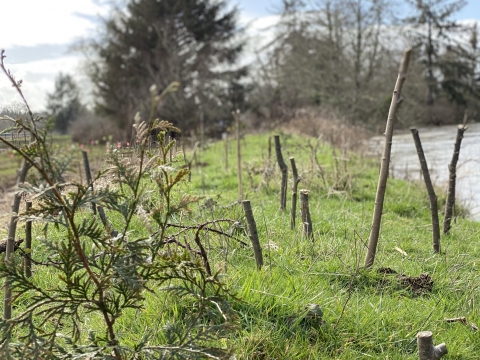Projects and Research
Drift Creek Riparian Restoration
Drift Creek, a tributary to the Siletz watershed, provides important spawning and rearing habitat for native salmonids and contains populations of Chinook and Coho salmon, winter Steelhead and Cutthroat trout. Populations of these and other species have been significantly reduced over the past 60 years, as a result of timber harvest, road construction and other activities.
To help salmon, the USFWS and its partners are restoring riparian riparian
Definition of riparian habitat or riparian areas.
Learn more about riparian habitat along Drift Creek. Thousands of native trees have been planted and invasive species invasive species
An invasive species is any plant or animal that has spread or been introduced into a new area where they are, or could, cause harm to the environment, economy, or human, animal, or plant health. Their unwelcome presence can destroy ecosystems and cost millions of dollars.
Learn more about invasive species like Himalayan blackberry are being removed. Once the trees mature they will harbor insects which can drop into the water where they become food for juvenile salmon. The trees also create critical shade in the summer that keeps the creek cool, a critical habitat requirement for salmon and trout because cooler water holds more oxygen, making it easier for fish to breathe. And when the trees are exposed to storm events or reach the end of their life, they will fall into or lose branches to the creek which help create pools in the water for small salmon to find cover and food. View the Environmental Assessment on a proposed action to restore estuarine habitat in the Drift Creek Unit of the Siletz Bay National Wildlife Refuge.
Climate Change Impacts to Tidal Wetlands
A team from Oregon State University and the US Geological Survey conducted research at the Siletz Bay National Wildlife Refuge to better understand climate change climate change
Climate change includes both global warming driven by human-induced emissions of greenhouse gases and the resulting large-scale shifts in weather patterns. Though there have been previous periods of climatic change, since the mid-20th century humans have had an unprecedented impact on Earth's climate system and caused change on a global scale.
Learn more about climate change impacts to tidal wetlands along the west coast of the US.
Siletz Bay NWR was added to a west coast-wide network of salt marsh salt marsh
Salt marshes are found in tidal areas near the coast, where freshwater mixes with saltwater.
Learn more about salt marsh sites developed by USGS researchers. With over two dozen sites in California, Oregon and Washington, the network enables a coast-wide comparison of sea-level rise impacts on tidal marsh habitats. At Siletz Bay NWR, high-accuracy RTK GPS produced digital elevation models and conducted vegetation surveys across Millport Slough and the Siletz Keys areas. Using these data, and information about sedimentation rates in past decades from deep sediment cores, the team modeled how different sea-level rise scenarios impact the distribution and composition of tidal marshes.
Tidal Marsh Restoration
While some refuge lands are acquired in a pristine state, other lands have been modified and require habitat restoration to reach their full biological potential. Restoration can take many forms, including planting native vegetation and restoring natural hydrological function to streams and tidal marshes using heavy equipment. Oregon has lost more than 75 percent of its salt marshes, a vital habitat for many species of wildlife and fish such as Coho Salmon. Habitat restoration efforts have focused primarily on these diked tidal wetlands at Siletz Bay.
Removing the dikes brings back the influence of daily tidal cycles and restores the natural hydrology of the marsh. Native plant species recolonize the marsh, sinuous tidal channels re-form, and fish return to inhabit historic and newly-created breeding and rearing areas.



